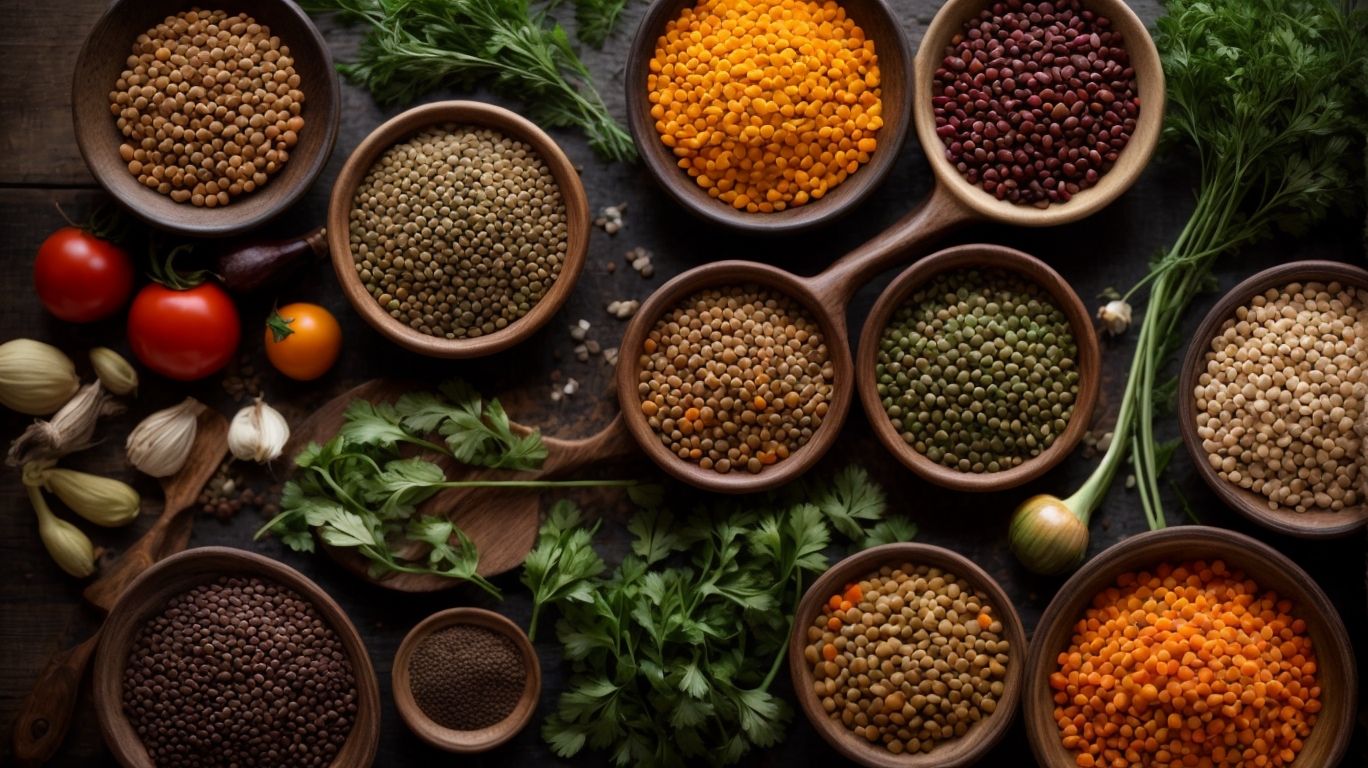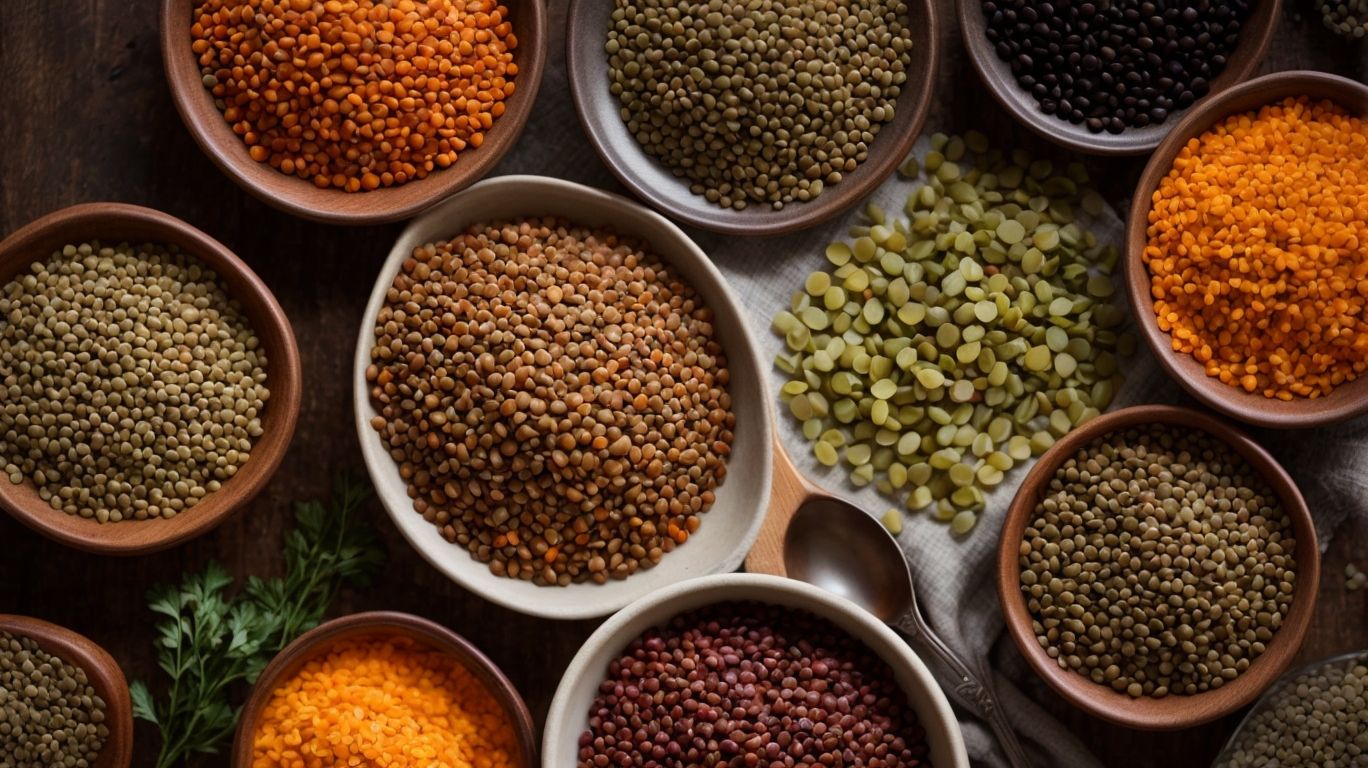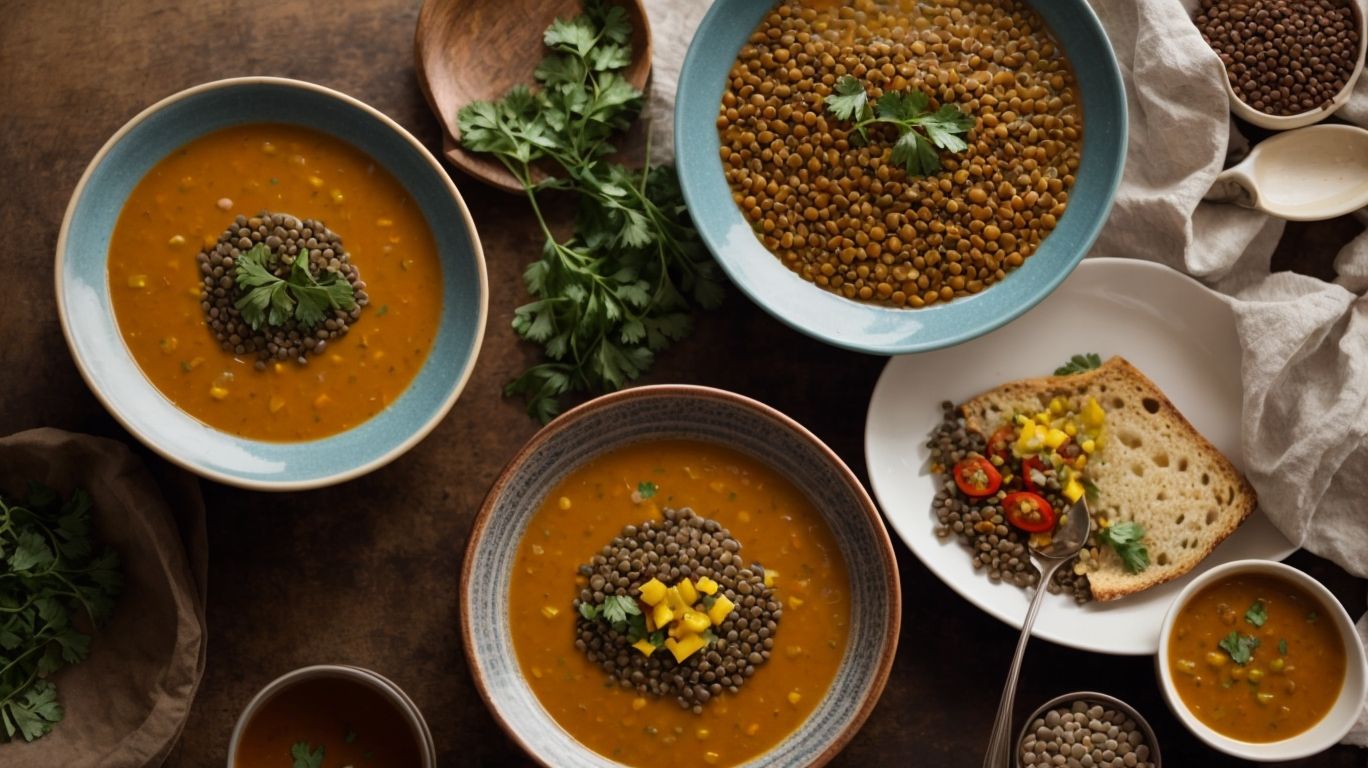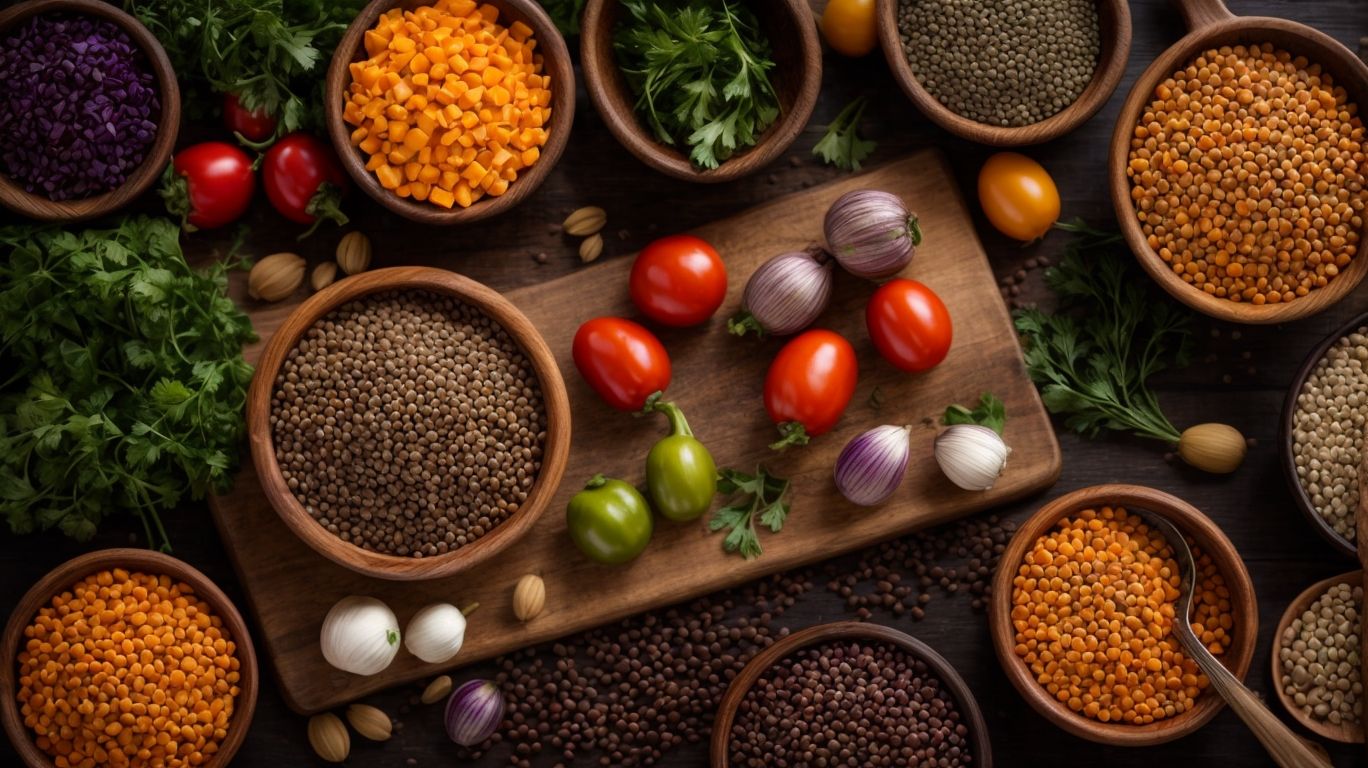How to Cook With Lentils?
Are you looking to add a versatile and nutritious ingredient to your cooking repertoire?
Explore everything you need to know about lentils – from the different types available to the nutritional benefits they offer.
Learn how to properly prepare and cook lentils and discover some delicious recipe ideas for you to try.
Whether you’re a seasoned chef or a beginner in the kitchen, get ready to experiment and enjoy the wonderful world of lentils!
Key Takeaways:
What are Lentils?

Credits: Poormet.Com – Elijah Flores
Lentils, also known as pulses, are edible seeds that belong to the legume family and are prized for their high nutritional value and culinary versatility.
These versatile legumes come in various colors such as green, brown, red, and black, each with its own distinct flavor and texture. For instance, red lentils are quick-cooking and perfect for soups and curries, while green lentils hold their shape well, making them ideal for salads and side dishes. Whether you’re making a hearty lentil stew, a comforting dahl, or a flavorful lentil salad, there’s a type of lentil to suit every culinary need. With their earthy taste and rich protein content, lentils are a staple ingredient in vegetarian cuisine and are widely embraced in global cooking traditions.
What are the Different Types of Lentils?
The world of lentils encompasses a diverse array of types, including French lentils, Beluga lentils, Regular Green, Brown Lentils, and Red Lentils, each offering unique flavors, textures, and culinary applications.
French lentils, also known as Puy lentils, are small and dark green with a peppery flavor. They hold their shape well when cooked, making them perfect for salads or side dishes.
Beluga lentils, resembling caviar due to their small size and black color, have a rich, earthy taste.
Regular Green lentils are mild with a sturdy texture, ideal for soups and stews.
Brown Lentils, slightly larger and earthier than green lentils, are versatile and commonly used in curries.
Red Lentils, which cook quickly and turn golden, break down easily, making them great for thickening soups and dal.
Why Should You Cook with Lentils?

Credits: Poormet.Com – Christian Garcia
Cooking with lentils offers a multitude of benefits, including being a healthy source of plant-based protein and fiber, ideal for vegetarian diets, affordable, meatless meal options that are pantry staples in many households.
Lentils are not only packed with protein and fiber but also rich in essential nutrients like iron, folate, and potassium. This makes them a well-rounded choice for anyone looking to maintain a balanced diet. Whether you’re whipping up a hearty lentil soup, a flavorful dal, or incorporating them into salads and stews, the versatility of lentils makes them a go-to ingredient in many kitchens.
For those following a vegetarian lifestyle, lentils can be a game-changer, providing a satisfying and nutritious alternative to meat-based dishes. Their budget-friendly nature makes them a smart choice for anyone looking to eat healthily without breaking the bank.
What are the Nutritional Benefits of Lentils?
Lentils are a nutritional powerhouse, packed with protein and fiber, making them an excellent choice for maintaining a healthy diet and lifestyle.
Protein is essential for building and repairing tissues in the body, and lentils provide a plant-based source that is lower in fat compared to animal proteins. This makes them ideal for those looking to manage their weight while still meeting their protein needs.
- The high fiber content in lentils promotes digestive health by supporting regular bowel movements and aiding in overall digestion.
- Lentils also have a low glycemic index, which means they release energy slowly, providing sustained energy levels throughout the day without causing spikes in blood sugar levels.
How Do Lentils Help with Weight Loss?
Lentils play a significant role in weight loss due to their high fiber and protein content, which promote satiety and support a healthy metabolism, making them a valuable ingredient in nutritious and fulfilling recipes.
By aiding in providing a feeling of fullness, lentils can help individuals manage their portion sizes and calorie intake, thereby contributing to weight management goals. The combination of fiber and protein in lentils can help stabilize blood sugar levels, reducing cravings and overeating tendencies.
Incorporating lentils into meals is versatile and delicious. For instance, a hearty lentil soup with vegetables can be a comforting and filling dinner option. Lentil salads with a mix of fresh greens, tomatoes, and a zesty vinaigrette dressing can make a satisfying and healthy lunch choice.
How to Prepare Lentils for Cooking?

Credits: Poormet.Com – Michael Brown
Preparing lentils for cooking involves steps like soaking, rinsing, and ensuring the right lentil-to-water ratio for optimal results in your culinary creations.
Soaking is a crucial process that helps to soften the lentils and reduce cooking time. To soak lentils, simply place them in a bowl or pot and cover them with water – the general rule of thumb is to use three cups of water for every cup of lentils. Let them sit for at least 2-4 hours or ideally overnight. After soaking, rinse the lentils thoroughly in a colander under running water to remove any dirt or debris.
Do You Need to Soak Lentils Before Cooking?
Soaking lentils before cooking is a common practice that helps reduce cooking time, improve digestibility, and ensure a consistent texture in your lentil-based dishes.
One of the key benefits of soaking lentils is that it can significantly reduce the cooking time when preparing your meals. By allowing the lentils to absorb water before cooking, you are essentially jumpstarting the hydration process, which leads to faster and more efficient cooking.
Soaking also aids in breaking down complex sugars and starches present in lentils, making them easier to digest. This can be particularly helpful for individuals who may find legumes hard on their digestive system.
When soaking lentils, it is essential to consider the optimal lentil-to-water ratio. Different types of lentils require varying amounts of water for soaking. For example, red lentils need a ratio of 1:2 (lentils to water), while green or brown lentils typically do well with a ratio of 1:3.
How to Properly Rinse and Drain Lentils?
Rinsing and draining lentils is crucial to remove impurities, excess starch, and enhance the flavor profile of your dishes, especially when working with different lentil types like French lentils, Red Lentils, or Beluga lentils.
French lentils, with their delicate flavor and firm texture, require gentle rinsing under cold water to maintain their integrity.
Red Lentils, on the other hand, need a more thorough rinse to eliminate excess starch which can cause them to turn mushy when cooked.
Beluga lentils, known for their caviar-like appearance, should be rinsed lightly to preserve their unique look while still ensuring they cook evenly.
How to Cook Lentils?
Cooking lentils opens up a world of culinary possibilities with various methods like boiling, simmering, or pressure cooking, allowing you to create delicious and nutritious dishes for any occasion, including meal prep.
Regarding boiling lentils, it’s essential to rinse them thoroughly before adding them to a pot of water. Simmering, on the other hand, involves cooking the lentils in a covered pot over low heat, allowing them to slowly soften and absorb flavors. If you’re looking for a quick and efficient way to cook lentils, using an Instant Pot can be a game-changer – it significantly reduces cooking time while retaining all the nutritional benefits of the lentils.
What Are the Different Cooking Methods for Lentils?
The versatility of lentils shines through in various cooking methods, from quick and easy preparations to slow simmering for rich, flavorful dishes that showcase the natural taste of lentils.
Some of the simplest ways to cook lentils involve boiling them until tender, making them ideal for salads or quick side dishes. However, for those looking to elevate their lentil game, consider simmering them with aromatic spices, vegetables, and broth for a more complex flavor profile.
Alternatively, you can roast lentils in the oven until they are crispy, adding a unique texture and nutty taste. Another popular method is to prepare lentils in a pressure cooker, significantly reducing cooking time while still achieving deliciously tender results.
What Are Some Tips for Cooking Lentils?
Mastering the art of cooking lentils involves understanding basic techniques, such as seasoning, timing, and ingredient pairings, to elevate your lentil recipes from good to outstanding culinary creations.
Regarding cooking lentils, the type of lentil you choose makes a big difference in the flavor and texture of your dish. For instance, red lentils are great for soups and stews because they break down easily, while green or brown lentils hold their shape well, making them perfect for salads and side dishes. Experimenting with different lentil varieties can add an exciting twist to your meals.
What Dishes Can You Make with Lentils?

Credits: Poormet.Com – Peter Perez
Lentils inspire a wide range of delectable dishes, including hearty soups, vibrant salads, aromatic curries, and innovative tacos, offering a burst of flavors and textures in every bite.
These versatile legumes can be found in a variety of cuisines across the globe, from the classic Indian dal to the savory Moroccan lentil stews and the refreshing Mediterranean lentil salads. Whether you’re looking to whip up a quick weeknight meal or impress guests at a dinner party, lentils are a go-to ingredient.
To incorporate lentils into your meals, consider adding them to salads for added protein and crunch, using them as a base for hearty soups, or spicing them up in flavorful curries. You can even stuff them into tacos for a unique twist on a traditional favorite.
How to Make Lentil Soup?
Crafting a satisfying bowl of lentil soup is a simple yet rewarding experience, blending nutritious ingredients, aromatic spices, and wholesome flavors to create a comforting and nourishing meal that is perfect for any occasion.
One of the best things about lentil soup is its versatility – whether you prefer a thick and hearty texture or a lighter broth-based soup, lentils can adapt to suit your taste. To start, gather your ingredients such as lentils, broth, onions, carrots, celery, and seasonings like cumin, coriander, and a touch of paprika for that extra depth of flavor.
Begin by sautéing your aromatics – onions, carrots, and celery – in some olive oil until they are softened and fragrant. This forms the flavor base of your soup. Then, add in your lentils and broth, along with any additional vegetables or protein you desire.
How to Make Lentil Curry?
Preparing a luscious lentil curry is an art that combines aromatic Indian spices, fragrant herbs, and creamy coconut milk to deliver a burst of flavors and textures that captivate the senses with each spoonful.
Start by rinsing the lentils thoroughly to remove any excess starch. In a large pot, heat oil and sauté onions, garlic, and ginger until fragrant. Sprinkle in garam masala, turmeric, cumin, and coriander, allowing the spices to bloom and release their essence.
Add the lentils and vegetable broth, bringing the mixture to a gentle simmer, allowing the lentils to cook until tender. For a milder flavor, reduce the amount of chili powder, or for a fiery kick, increase it to suit your taste buds.
Serve the lentil curry piping hot over fluffy basmati rice, garnished with fresh cilantro and a dollop of cooling yogurt. Accompany this dish with warm naan bread or crispy papadums for a complete Indian dining experience.
How to Make Lentil Salad?
Crafting a vibrant lentil salad is a delightful culinary journey that combines nutritious lentils with fresh vegetables, zesty dressings, and aromatic herbs, resulting in a refreshing and satisfying dish reminiscent of Mediterranean flavors.
To start this culinary adventure, begin by cooking a batch of herbed farro according to the package instructions. The addition of herbed farro brings a wholesome and nutty element to the salad, complementing the earthy flavors of the lentils perfectly. Once the farro is ready, transfer it to a large mixing bowl and allow it to cool slightly.
Next, prepare a lemon vinaigrette by whisking together freshly squeezed lemon juice, extra virgin olive oil, minced garlic, Dijon mustard, and a pinch of salt and pepper. This bright and tangy dressing adds a burst of citrusy flavor that ties all the components of the salad together.
Conclusion: Experiment and Enjoy!
The world of lentils offers a culinary playground where you can experiment with flavors, textures, and global cuisines to create delicious and versatile dishes that cater to all tastes and preferences.
Whether you choose to whip up a comforting lentil soup on a chilly evening or add some protein-packed lentils to your vibrant salads, the options are truly endless. Integrating lentils into your cooking repertoire not only enhances the nutritional value of your meals, but also brings a rich depth of flavor and hearty satisfaction.
From spicy lentil curry to zesty lentil salads, each dish showcases the Art of colorful lentils in a delightful manner. Explore different lentil varieties like lentil dals, lentil stews, and lentil burgers to infuse your meals with a burst of heartiness and nutrition.
Frequently Asked Questions
What are lentils and how do I cook with them?
Lentils are legumes that are packed with protein, fiber, and essential vitamins and minerals. To cook with them, simply rinse and sort through them before adding them to your dish.
Can I cook lentils without soaking them beforehand?
Yes, unlike other legumes, lentils do not require soaking before cooking. However, you can soak them for 1-2 hours to help reduce their cooking time.
What is the best way to cook lentils?
Lentils can be cooked on the stovetop, in a pressure cooker, or in a slow cooker. The stovetop method typically takes 20-30 minutes, while the pressure cooker and slow cooker methods take 10-15 minutes.
Do I need to season lentils before cooking?
While lentils have a mild flavor, adding seasonings such as garlic, cumin, and chili powder can enhance their taste. You can also add them to soups, stews, and salads for a flavorful boost.
How do I know when lentils are fully cooked?
Lentils are fully cooked when they are soft and tender, but still hold their shape. You can taste test them to see if they are done, or follow the recommended cooking time in your recipe.
What are some creative ways to use lentils in cooking?
Aside from traditional dishes like lentil soup or curry, you can use lentils in veggie burgers, pasta sauces, and even as a substitute for ground meat in tacos or chili. Get creative and experiment with different flavor combinations!





